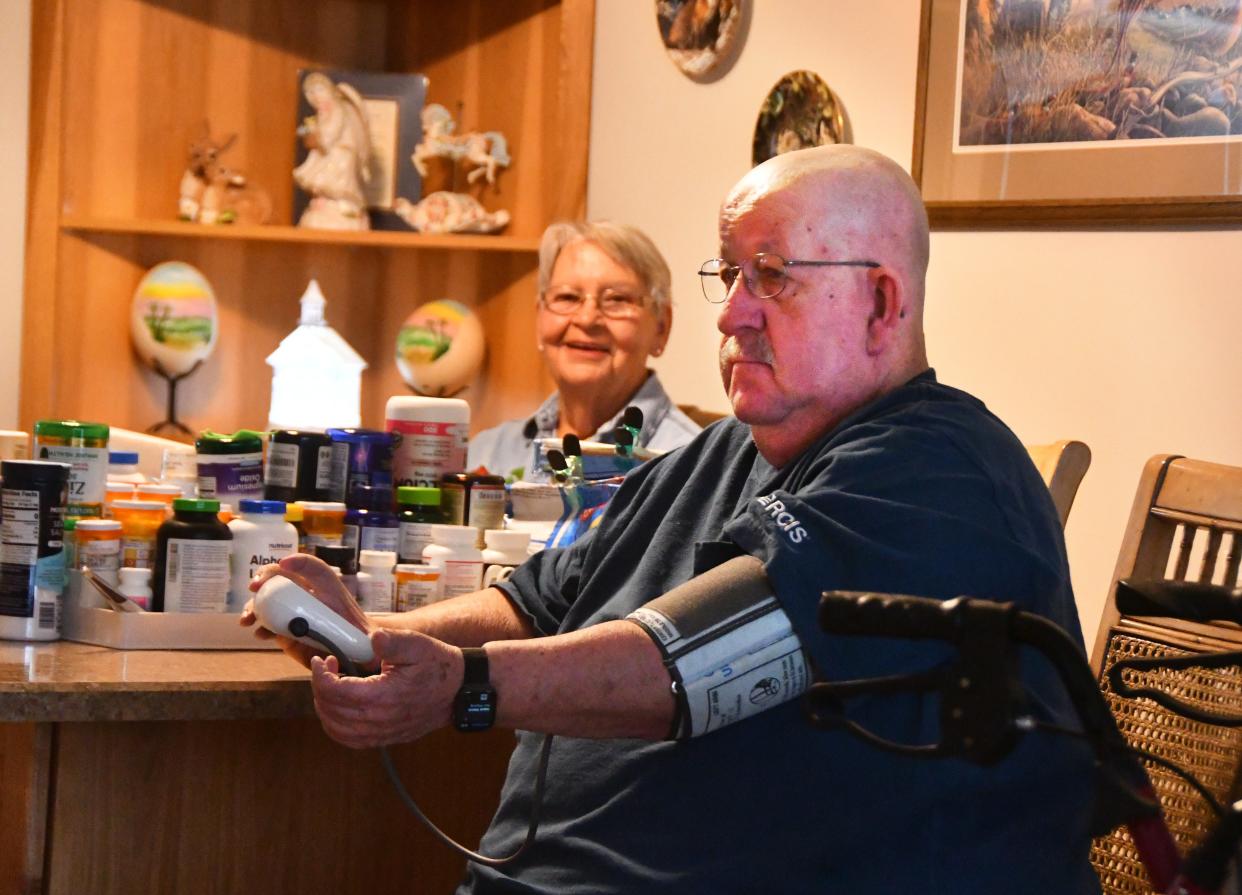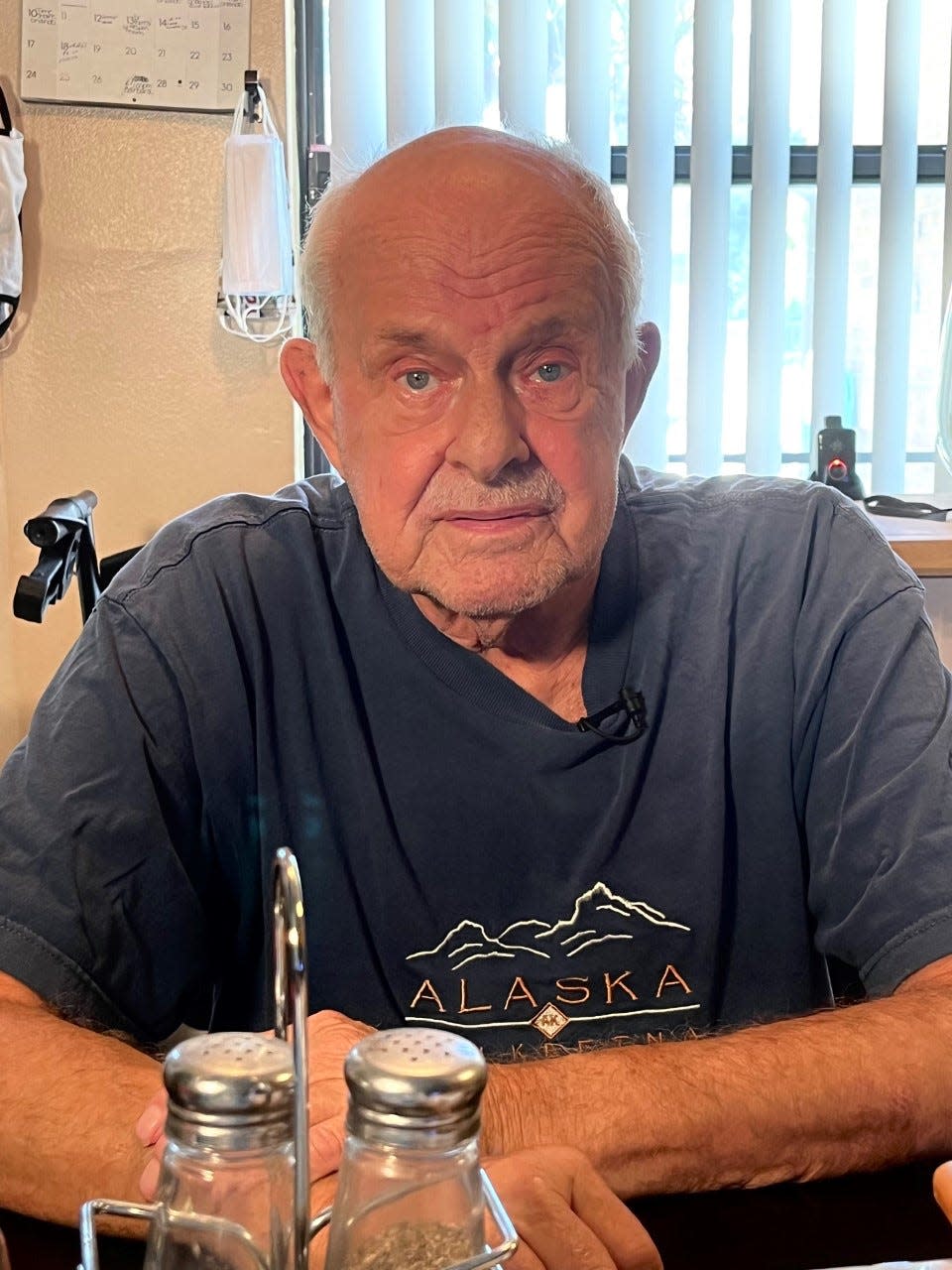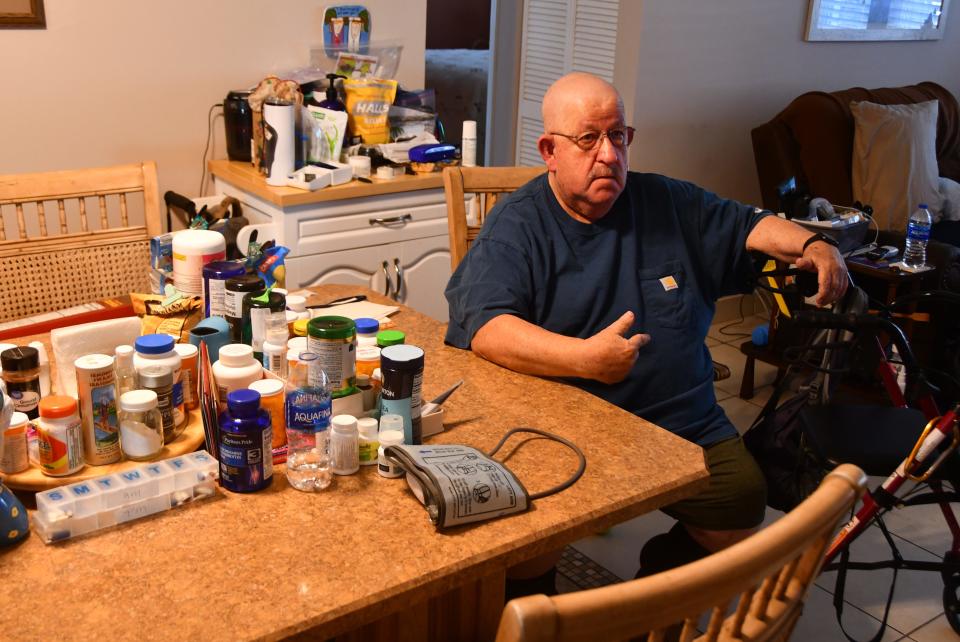Healing at home: Health First program offers 'hospital-level care' option for patients

Eury Holliday went to the emergency room at Health First's Holmes Regional Medical Center in Melbourne in 2021, expecting a wait and, possibly, a hospital stay.
The 83-year-old Palm Bay man has chronic obstructive pulmonary disease. His wife of 64 years, Helen, has her own litany of health problems.
Instead of being admitted, however, he was treated and told about Health First At Home Inpatient Services.
The program allows patients coming to the Health First emergency departments at Holmes, Palm Bay Hospital or Viera Hospital for one of numerous conditions to be eligible for potential treatment at home with what Health First describes as "hospital-level care."
Holliday became the first patient to participate in the program in June 2021.

He is one of about 325 people who have been treated through Health First At Home, and he's pleased with how it turned out ― from the treatment to the reduction in stress for him and his wife.
"I said, 'Coming home? It's a lot better than staying in the hospital,' " Holliday said. "I had daily visits ― one group that came during the day and another in the evening. … They gave me breathing tests and shots, took my blood, all that stuff. Basically, everything they would have done in the hospital, but it was a lot better than being in there."
Holliday knew he was being watched carefully, he said, when he got a phone call after 1 a.m. It came from one of his health care team.
"She called and said, 'Your breathing tube fell off or shut off,' " Holliday said. "It had, and my oxygen was low."
Experts believe that, by 2025, around 30% of patients normally cared for in a hospital environment will be cared for at home, according to the American Hospital Association.
Holliday said it was a better choice for him in every way, easing his concerns about his wife's health and security while getting the treatment he needs.
"Plus, it's more convenient — if I want a snack, I just go to the refrigerator," he said, laughing.
Health First said among the medical conditions in which patients can qualify for this program are asthma, bronchitis, cellulitis, chronic obstructive pulmonary disease, congestive heart failure, COVID-19, dehydration, simple pneumonia, skin infections and urinary tract infections.
Health First is one of about a half-dozen hospital systems in Florida that offer a home-based hospital care program. Nationwide, there are 114 hospital systems encompassing 258 hospitals in 37 states with hospital-at-home programs.
"It's a new way of doing things," said Dr. Mark Rosenbloom, Health First's vice president of clinical transformation. "The literature to date really shows that there's a lot of improvements in outcomes. Patients just do better at home than they do in the hospital.
"What better place for a person to be taken care of than in their home? How more customer-centric could you be? And if you're getting better results, even better. So I really think it's a combination of improving health and wellness, and focusing on the best interests of the customer."
Joseph Lavelle, Health First's vice president for hospital-based providers, said the program is designed to replicate the care provided at a brick-and-mortar hospital, but without the hospital environment.
Sharing meals:Melbourne Beach couple on mission to help homeless, one vegan meal at a time
Rosenbloom added that "it's just an opportunity to take what we've traditionally done in the hospital, and move it to a more friendly environment."
Lavelle said the program began at Health First in June 2021 to deal with a surge in COVID-19 patients, and was refined since then, "really to offer the same level in-patient care and safety that you have within the bricks-and-mortar (hospital) setting in a patient's home."
Health First actually had been in initial planning since 2019 for starting such a program. The COVID-19 pandemic, along with a Centers for Medicare & Medicaid Services waiver program for payment of medical bills, were triggers that got the program in operation.
"The timing was fortuitous, because I believe that the program really helped decompress our hospitals at a time when things were very, very busy due to COVID," Rosenbloom said.
Melissa Lutz, Health First At Home nurse manager, said that as the program developed, "we were able to build our program to take care of all these respiratory patients who, unfortunately, have a lot of the chronic illnesses. And we're able to give them more time with their family in the most intimate setting, which is their home."
Currently, people who have Medicare coverage and those who have Health First Health Plans medical coverage are eligible to be part of the program. Health First officials are hoping that other private health insurers offer such coverage in the future.
Remote monitoring focus
A key component to Health First’s At Home program is its remote telemonitoring services. The remote patient monitoring and care management technology is monitored by Health First’s electronic intensive care unit team.
“We use a remote patient monitoring platform that provides the heart rate, respiratory rate, oxygen saturation and skin temperature and activity level,” Rosenbloom said. “It integrates with a tablet that also can be used for virtual visits with a physician, with a nurse, social worker or therapist."
This program also provides Health First's critical care physicians and nurses the ability to monitor real-time vital signs, laboratory results and complete electronic medical records of patients who are physically in the various intensive care units at all four Health First hospitals from a central location. That includes Health First's Cape Canaveral Hospital in Cocoa Beach, which currently is not part of the At Home Inpatient Services program.
Safety checks to qualify
Lutz said, before folks are enrolled in the At Home program, the patients, along with their home settings, are evaluated to assure the program is "medically safe" and appropriate for them.
For example, the patient should have some technical knowledge to use the computer tablet, should have a social support system and should be comfortable being in the program.
"We do safety checklists, not only for the environment, but also for their mobility, safety within the home, ability to understand education and the direction to be safe at home, as far as answering the phone, having a small amount of tech knowledge to answer a cell phone, utilize a tablet, because our monitoring system utilizes a tablet and feed that goes into a platform that we utilize called Current Health," Lutz said.
A patient's medical vital signs are continuously monitored remotely with the help of a small disc that is placed on the patient's arm.
"We also have to go through with medical clearance — they are medically safe to continue their treatment at home ― as well as their social environment that they have," Lutz said. "If they do live at home alone, they have someone who is immediately nearby, in case we need to get ahold of someone, an emergency contact. And they also have to consent to the program.
"So just because they may fit that criteria does not mean that we can just take them from their bed in the hospital, and put them in our program. They have to consent in order to be treated within the program."
Funding priorities: Brevard commissioners set legislative priorities for state action, from roads to aquarium
In some cases, physical modifications are made to the person's residence, including having a hospital-style bed brought to the home.
Lutz said Health First also tries to assure that the patient has nutritious food to eat at home, and that their spouse or another family member is involved in the personalized care plan, "so that everybody is on the same platform, and everybody understands what our next step is."
One-on-one care
Health First said patients in the program receive:
Transportation to their home, if needed.
Support from a dedicated coordinator who guides their care.
Delivery and setup of all necessary equipment, medications and supplies.
Around-the-clock remote monitoring of their vital signs by Health First's clinical team.
Daily in-home or virtual visits from a registered nurse.
Daily in-home or virtual visits from a nurse practitioner, physician assistant or physician.
Support to coordinate needed services and follow-up appointments after discharge.
Lutz said the program allows for a closer one-on-one, individualized level of care for patients.
"We get the opportunity to actually sit with our patients at length, actually educate our patients, truly confirm that they understand what we're explaining to them, what the disease process is, what to expect about their care … and what we expect from them as part of journey to their recovery,” Lutz said. “We're able to truly connect with patients the way that we intended to connect with patients ― back when we were aspiring nurses in nursing school. It takes us back to the true core of the caregiver-patient relationship."
Lavelle added that "when that nurse comes out to the home, that nurse is focused on you and the family members. They don't have to run down the hall for an emergency code that might be occurring. They're focused exclusively on you, providing you with that acute level of care. So that's a big deal. And that's what the family members and the patients recognize also. We've got the time for them."
Lutz said Health First has an 11-person team specifically assigned to the program, most of them in the nursing field.
A number of other Health First staff members also are involved in the program, in conjunction with other duties.
Lavelle said, from a staff perspective, he has noticed nurses in the program like their new role, and it helps avoid burnout that could come from nursing in a hospital setting.
"This hospital-at-home business model really offers the additional potential for addressing nursing burnout," Lavelle said. "My observation of the nurses who cover this program is that you can feel their renewed sense of joy in caring for their patients. While their job is no less complex than if they were on the traditional hospital unit, in the home environment, they're not interrupted, and they can spend more time with the patient, more one-on-one care. And the patients feel that. And the nurses feel that."
Positive outcomes, satisfaction
Lutz said a typical stay in the program is two to three days.
Lavelle said, compared with a traditional hospital stay, for patients with the same medical condition, the average time length of treatment is shorter with the at-home program and the average cost per case is lower.
He said patient satisfaction in the at-home program "is universally through the roof," with a satisfaction rate of more than 90%.
Lavelle said many patients also say they sleep better at home, compared with being in a hospital room.
"Because they sleep better, they walk around more, are more mobile, and it just contributes to the overall care plan," Lavelle said. "To be able to be treated where the patient is, with the same level of care, is really the motivation of the system."
Research published in major medical journals shows those trends in similar programs elsewhere in the country.
For example, a research paper published in the journal Annals of Internal Medicine, "Hospital-Level Care at Home for Acutely Ill Adults," found that at-home patients were less sedentary during their stay than in-hospital patients, based on a study involving patients of two Boston hospitals. Also, the patients were less likely to be readmitted for the medical condition during the following 30 days; they had fewer "patient safety events" like falls or delirium; and the cost of their care was lower.
'Tired of being in the hospital'

Daryl Wattenbarger said he is pleased with Health First's at-home program.
Wattenbarger has been in and out of the hospital with stubborn bouts of sepsis whose cause has yet to be determined.
"I just got tired of being in the hospital," said the 73-year-old, who works remotely from his house in Palm Bay.
"I chose this program because, when I go home, I'm here with my dog. For my wife, it's less stress on her, having to run back and forth from the hospital. And I get good food."
The wireless, wristwatch-style apparatus Wattenbarger wears on his wrist alerts his health team to all his vitals, and he has a direct line to the doctor. Any problems that crop up are noted by the telemetry of the band, helping the team determine whether he needs to come back to the hospital, "or whether they need to send the nurse out," he said.
His wife, Kathy, is able to give him the antibiotics he needs through a special catheter every 12 hours.
He also likes knowing that if and when he does have to go to the hospital while on the program, he'll be treated as if he'd been there all along.
"I'm technically in the hospital, so it's nice to get to go right to the front for bloodwork or whatever, instead of having to wait to get tests," he said.
"It's like being in the hospital 24 hours a day, but I'm not taking up space needed by someone who's worse off than I am."
Rosenbloom sees the hospital-at-home program as "the first step of what the future could look like."
"We're leveraging technology," Rosenbloom said.
"So how can we use the same type of principles with people with chronic illnesses, to monitor them, to keep them from deteriorating, to keep them from having to come to the hospital? I think there's all kinds of things that we can do down the road to improve the health and wellness of the folks in Brevard County, with technology, with virtual visits, with remote patient monitoring. There's a whole ecosystem out there that this sort of at-home care can lead us to. And I think there's lots of benefits to that in the future."
Contact Berman at dberman@floridatoday.com, on Twitter at @bydaveberman and on Facebook at www.facebook.com/dave.berman.54.
Contact Kennerly at bkennerly@floridatoday.com. Twitter: @bybrittkennerly Facebook: /bybrittkennerly.
This article originally appeared on Florida Today: Health First program offers 'hospital-level care' in home setting

